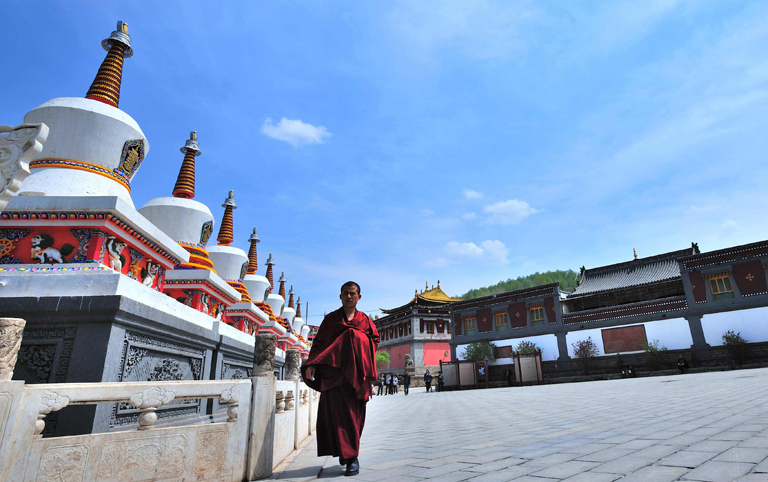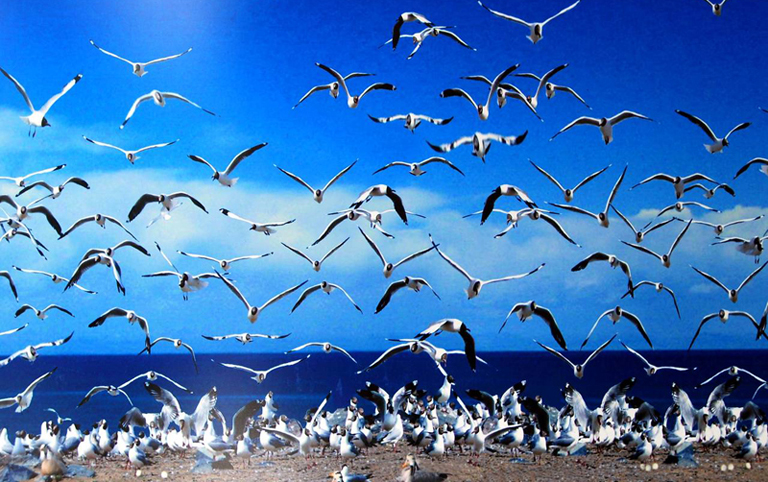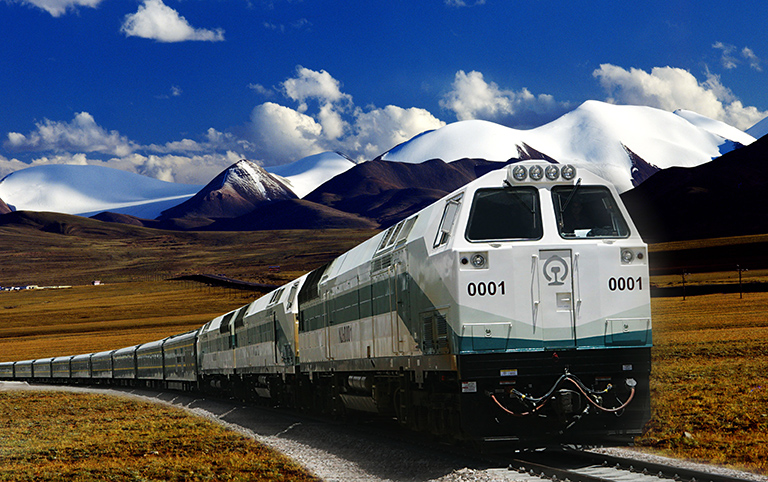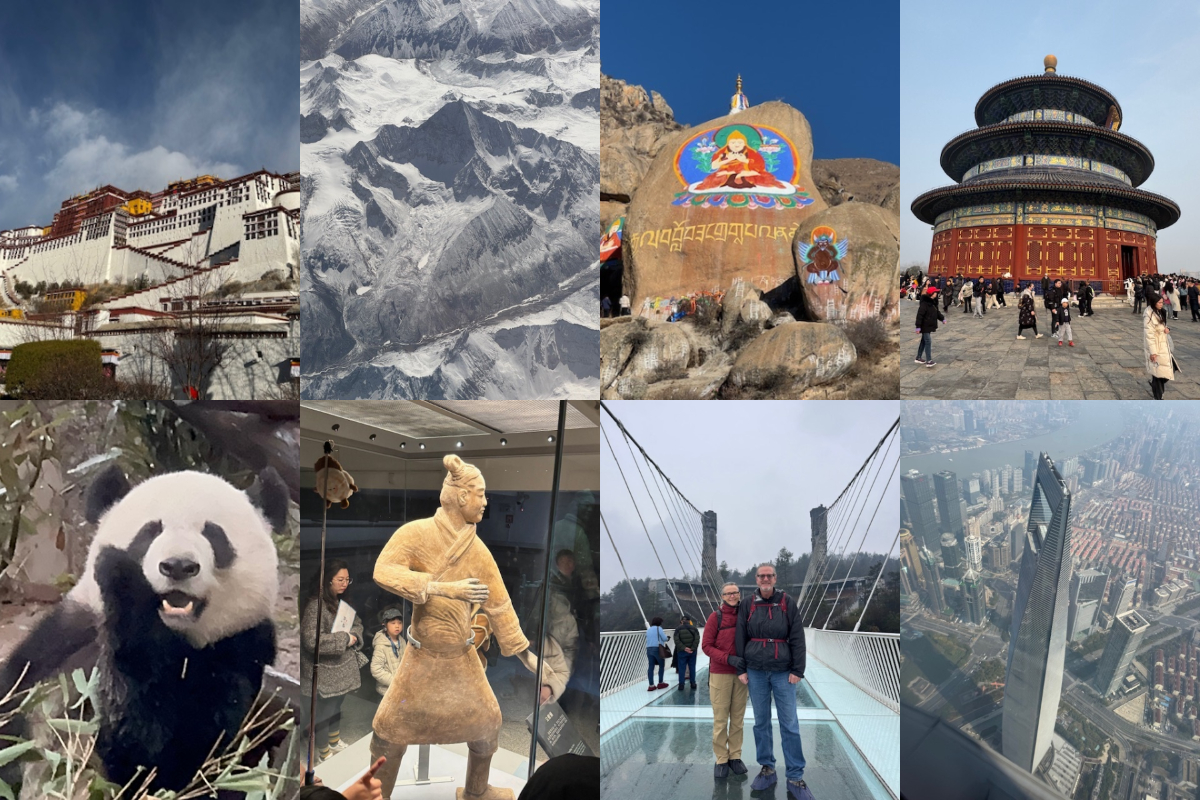It is now very popular with tourist to take a train across the Tibetan Plateau from Xining to Lhasa. The distance between Lhasa and Xining is 1,972km (about 1,233 miles). On this train tour, you will pass the sparsely populated Kekexili Nature reserve in Qinghai-Tibet Plateau; see wild animals through the train window; and enjoy the breathtaking natural beauty of Plateau lakes and snow-covered mountains along the train line.
Highlights of this tour:
- Ride a traditional Chinese train to Tibet on the highest railway in the world - Qinghai-Tibet Railway;
- Climb up the grandiose Potala Palace and visit sacred Buddhist temples and monasteries in Lhasa, such as Jokhang Temple, Drepung Monastery;
- Learn about Tibetan Buddhist culture and experience the devout atmosphere in the holy city.
Tour Brief Information
- Tour price: from Request
- Tour code: TD-TT-06A
- Tour Type: Private Customizable Tour Package
- Destination: Xining - Lhasa
- Duration: 6 days and 5 nights
- Departure: Flexible
- Travel Theme:





- Best Time:



- Physical Level
- Tour Pace
Tight
- Max Altitude
5,210m
- Itinerary Details
- Price Guide & Booking
- Trip FAQs
- Reviews
- Make an Enquiry
Your tour - at a glance
Day 1~3 Xining Tour & Train to Lhasa
Day 4~5 Lhasa City Tour
Day 6 Lhasa Departure
Itinerary Details - Day by Day
Day 1 Xining Arrival
Upon arrival at Xining airport, be met and escorted to your hotel in Xining. Xining is the capital of Qinghai province. Xining is a very religiously diverse city with large numbers of Buddhists, Daoists, Christians, and Muslims. The average temperature in Xining during the summer is 17-19 degrees Celsius which makes it a very cool place to visit for summer vacation. The altitude in Xining is 2,260m. If time allows, a visit to Ta'er Monastery can be arranged for you. Ta'er Monastery is the religious activity center for monks and followers of the Gelugpa Sect. Stay overnight at Xining.
-
 Pagodas of Buddha Shakyamuni in Taer Monastery
Pagodas of Buddha Shakyamuni in Taer Monastery
Day 2 Xining - Qinghai lake ( B,L,D )
After breakfast, you will be driven to visit Qinghai Lake, 150km west of Xining. It covers a vast area of over 4,500 sq km, the largest lake in China, at a height of 3,200m (10,500ft) above sea level. The region around the lake is home to many Tibetan Nomads, whose yaks and sheep graze near the lake. There used to be an annual ceremony to the "God of the Lake", though this ceremony is no longer held. In the summer, herbs can be seen everywhere. Drive back to Xining for the train to Lhasa in the afternoon or evening. Spend the night on the train.
Tips: Be sure to bring snacks with you for the train ride. During parts of your journey on the train the altitude will approach 5,000m.
-
 Qinghai Lake with Enchanting Natural Beauty
Qinghai Lake with Enchanting Natural Beauty
-
 The Paradise of Birds
The Paradise of Birds
Day 3 Lhasa Arrival
Witness the beautiful Tibetan Plateau with groups of nomads. See the Kekexili Nature Reserve which protects wild plants and animals as well as their natural habitates.
After arrival at Lhasa in the afternoon, you will be picked up by local tour guide at Lhasa Railway Station, and then be escorted to your hotel in Lhasa city in a private vehicle.
High Altitude Acclimation Tips: 1) Go for some leisure walking to acclimate the high altitude but avoid strenuous activity after arrival; 2) you’d better not have bath, in case of catching a cold; 3) Drink more water, and have some fruit; 4) Have a good rest.
-
 Train to Lhasa offers a good view of the high plateau
Train to Lhasa offers a good view of the high plateau
Day 4 Lhasa ( B )
Start today’s Lhasa exploration with an exciting visit to the landmark - Potala Palace which is regarded as one of the most beautiful architectural building in the world. You will climb up the palace along the zigzag stone paths with white-and-red walls to the top of the palace where you can not only appreciate the exotic Tibetan-style architecture, but also get a great view of Lhasa’s urban areas, then walk into the inner space of Potala Palace to explore the stately chapels and learn about the history of the palace.
Continuing your exploration, you will then get to Jokhang Temple which is considered as the spiritual heart of Tibetan Buddhism. Each day, there are thousands of pilgrims coming from different places in Tibet to the temple to worship to the Buddha. This temple is also known as the “house of Buddha” because it keeps the precious Jowo Rinpoche, the life-sized (5 foot/1.5m) image of the Shakyamuni at the age of 12. The last site for today’s exploration is the famous Barkhor Street. It is a circular and wide street encircling the Jokhang Temple. The local people like to walk on the street for several circles usually in the late afternoon as a daily tradition of pilgrimage. The street also has many shops selling a wide variety of traditional Tibetan goods, religious items and handcrafts.
Tips of Today: 1) there are 1,080 steps up to climb to the top of Potala Palace, so don’t walk in a rush, which may cause high altitude sickness; 2) taking photos is not allowed inside the palace; 3) today you will be mainly outside, please bring some water, a hat, sun cream, and sun glasses with you.
-
 Amazing Potala Palace in the morning
Amazing Potala Palace in the morning
-
 Prayers at Jokhang Temple
Prayers at Jokhang Temple
-
 Barkhor Street
Barkhor Street
Day 5 Lhasa ( B )
After breakfast, you will firstly go to visit the beautiful Norbulingka which used to be the former summer palace of Dalai Lamas in the ancient time, and now is a public park. It is famous for its Potrang, the private palaces of former Dalai lamas with grandiose Tibetan architecture style. Next, drive several kilometers to the western outskirts of Lhasa to visit Drepung Monastery. Drepung, in Tibetan, means “prosperity”. Since its establishment, Drepung Monastery has always been one of the most important Buddhist monasteries in Tibet. In its heyday, there were more than 10,000 monks lived and studied in the monastery. Throughout its history, many important and famous Tibetan leaders used to study here, especially the Dalai Lamas. So Drepung Monastery is also respectfully known as the “Mother School of Dalai Lamas”.
In the afternoon, you will be taken to another famous monastery in Lhasa - Sera Monastery. It is famous for the spectacular “Buddhism Debating”. As a daily routine, the monks gather in a courtyard, and debate on the Buddhist doctrines with supplemented gestures, which is thought to be helpful to facilitates better comprehension of the Buddhist philosophy to attain higher levels of study. After enjoying the "Buddhism Debating", you will be transferred back to the city. The rest time is your own free time to rest.
The Etiquette of Visiting Monastery: 1) you shouldn’t wear short and uncover shoulders; 2) taking off your sunglasses and hat before entering the chapels; 3) taking photos is usually not allowed inside the chapels.
-
 Scripture Debating is a good way to check the knowledge
Scripture Debating is a good way to check the knowledge
-
 Monks Gathered at the Entrance of Drepung Monastery
Monks Gathered at the Entrance of Drepung Monastery
-
 Appreciate the beauty of Thangka in Norbulingka
Appreciate the beauty of Thangka in Norbulingka
Day 6 Lhasa Departure ( B )
Today is free for you until your tour guide transfer you to the airport in time for your flight or drop you off at Lhasa train station.
Tips of Today: 1) please pack your luggage carefully, especially for small things like camera charger, power adaptor, mobile phone, phone charger, wallet and towel; 2) If your flight is arranged in the afternoon, please make sure you check out the hotel before 12pm.
Useful Trip Notes
-
- 1. Tibet Permits Guaranteed
To travel in Tibet, all Non-Chinese passport holders need to have a Tibet Travel Permit which is issued by Tibet Tourism Bureau in Lhasa. And only Chinese travel agencies like Tibet Discovery can apply for the permit on behalf of tourists. You must obtain it before your tour starting because the permit will be checked when you board your flight/train to Tibet. Traveling with Tibet Discovery, you don't have to worry about the complicated procedures of Tibet Travel Permit application. All you have to do is to confirm a tour package with us and send us your passport and Chinese visa copies at least 15~20 days in advance before your tour, then we will take care of all the rest things. Once the permit is issued, we will deliver to your address in China, such as your hotel, local travel agency, etc.
-
- 2. Available Months to Visit Tibet
Generally speaking, April to October is the best time. July and August are the peak season and rainy season. It is usually snowy and cold in winter, which is not suitable for visit Mount Everest, Namtso and Mount Kailash regions. While other places such as Lhasa, Gyantse and Shigatse are suitable for travel all year around. The temperatures in daytime and night differs a lot, usually 5~15℃ in the daytime and -5~0℃ in the night, so please wear accordingly.
-
- 3. High Altitude Sickness
The average altitude of Tibet is about 4000 meters above the sea level (Lhasa: 3700m; EBC: 5200m; Namtso: 4718m). You may suffer a bit from High Altitude Sickness in the beginning days of your Tibet trip if you haven’t had rich high plateau travel experience. But don’t worry too much, the high altitude can be acclimatized usually in 2~3 days. Our suggestion is to take a physical examination and get suggestions from your doctor, and also bring some medicines to prevent from High Altitude Sickness before your trip. While in Tibet, you should keep warm all the time, avoid strenuous activities, drink more water and eat more vegetables and carbohydrates. You’d better not take showers during the first two days after your arrival in Tibet. If you don’t feel well, get help from your tour guide or go to the hospital without any delay.
-
- 4. How to Go to Tibet
Basically you have two options – flight and train. Currently, you can take a flight to Lhasa from Beijing(4.5hrs), Xian(3.7hrs), Chengdu(2.5hrs), Chongqing(3hrs), Kunming(3hrs), Kathmandu (1.5hrs), etc. Among all these cities, Chengdu and Xian have more frequent flights to Lhasa.
If you prefer a train travel, you can take a train to Tibet from Beijing(40.5hrs), Xian(32hrs), Chengdu(43hrs), Shanghai(47hrs), Chongqing(42hrs), Lanzhou(25hrs), Xining(22hrs), Guangzhou(54hrs). -
- 5. Packing and Wearing Ideas
Firstly you can’t forget your passport and Chinese Visa. A large backpack and a smaller one are recommended (the smaller one can be used for daily activities). Also bring necessary medicine you need. Other stuffs like sunglasses, snow glasses, hats, lip balm, sun block are recommended.
As for wearing, you are suggested to dress in layers (both thin and thick jackets). Down jacket is necessary in Spring and Autumn. A pair of durable and comfortable shoes is necessary.
Recommended Tibet Group Tour Packages
Escorted by a skilled driver and companied by a professional local tour guide to organize all the activities, all you have to do is to enjoy your fantastic Tibet journey.Following are some other recommended Tibet group tour packages that you may be interested in. You can also contact us to customize a trip if you want..
-

Shanghai / Lhasa
8 Days Lifetime Tibet Train Tour from Shanghai
Highlights: Yu Garden, Qinghai Tibet Railway, Potala Palace, Jokhang Temple
-

Chengdu / Lhasa
7 Days Lifetime Tibet Train Tour from Chengdu
Highlights: Chengdu Panda Base, Qinghai Tibet Railway, Potala Palace








 Karen
Karen Wonder
Wonder Jack
Jack Rita
Rita Johnson
Johnson Vivien
Vivien Wing
Wing Ariel
Ariel Leo
Leo Tracy
Tracy Evelyn
Evelyn April
April Phoebe
Phoebe Kelly
Kelly Shirley
Shirley Reya
Reya Juliet
Juliet Elk
Elk Felix
Felix Sean
Sean